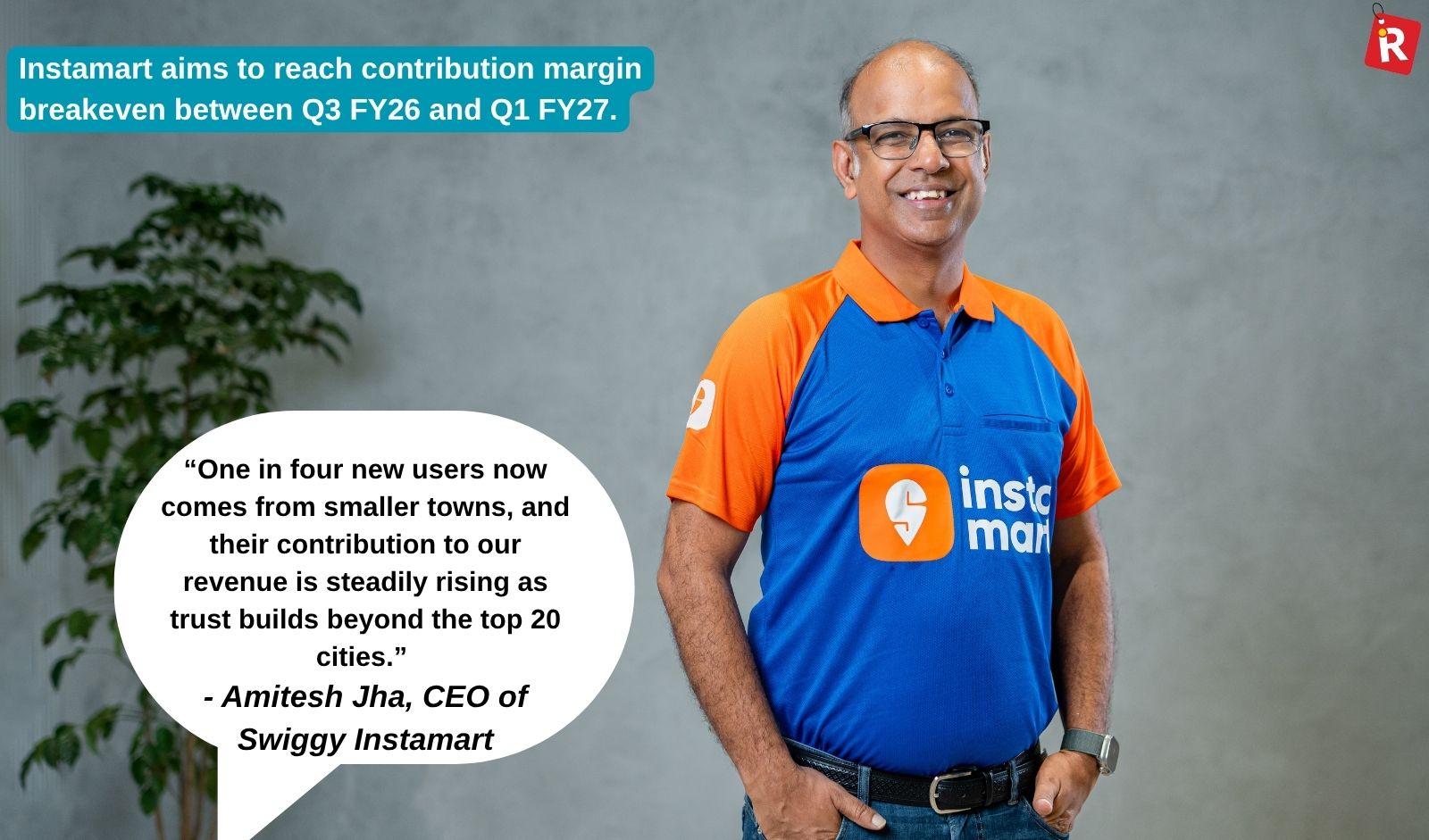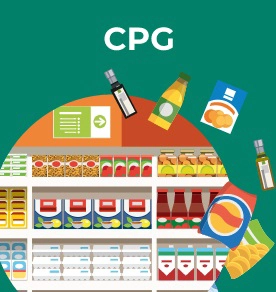How Instamart is Powering India’s 10-Minute Economy

Instamart has transformed quick commerce in India from a bold experiment into a Rs 5,655 crore business that now serves over 11 million monthly users across 125+ cities.
By Vaishnavi Gupta, Associate Editor
Oct 20, 2025 / 18 MIN READ
When Swiggy launched Instamart in 2020, quick commerce wasn’t even a term in India. Delivering groceries in minutes felt more like a fantasy than a feasible business model. Even globally, there was no proven framework for such an ambitious concept. Looking back, Amitesh Jha, CEO of Instamart admitted, “I didn’t give it much credit myself during my e-commerce years. But having brought convenience to food delivery, we at Swiggy saw an even bigger opportunity in grocery—a category 30 times larger. People may not need food delivery every day, but groceries are a daily essential.”
What began as an experiment with 2,000–3,000 SKUs focused on top-up or urgent needs quickly evolved into something much bigger. The platform that started with daily staples and fresh produce now caters to an expansive universe of consumer demands. “In 2023, the most searched items on Instamart were bedsheets and pillows, which proved that customers were looking for far more than just groceries,” stated Jha. Today, Instamart offers more than 35,000 products spanning across categories such as makeup, electronics, toys, fashion, pet care, and even gold. In one striking example, a customer in Kerala purchased Rs 8.3 lakh worth of gold through the platform. “We’re now delivering everything from protein powders to pressure cookers in just 10 minutes,” he added.
A Growth Story Like No Other
What started as a grocery-led initiative has now transformed into one of the most trusted quick commerce platforms in India. Instamart is supported by a robust network of 1,062 dark stores spanning 4.3 million sq. ft. of capacity. In addition, Swiggy has introduced 59 mega-pods, larger-format dark stores that carry three times the assortment of regular stores. These innovations have helped the brand achieve industry-best delivery times as low as eight minutes in top metros. The scale and speed have enabled Instamart to become nearly two-thirds the size of Swiggy’s food business in terms of gross order value (GOV).
“Instamart’s journey has been about proving the impossible possible. Today, we have built a hyperlocal supply chain with strong operational discipline, supported by automation and AI at every layer,” explained Jha. “We’ve steadily improved contribution margins through larger baskets and a growing mix of non-grocery items. This balance of assortment and efficiency has been key to our success.”
The numbers reflect this momentum. Instamart’s GOV grew by 107.6 percent year-on-year in Q1 FY26 to Rs 5,655 crore, while average order values rose 25.6 percent to Rs 612. The platform now serves 11.1 million monthly transacting users and continues to scale rapidly across India.
Going Beyond Metros
Instamart is no longer just a metro story. Today, the platform operates in more than 125 cities, with Tier II and III markets emerging as significant growth drivers. “One in four new users now comes from smaller towns, and their contribution to our revenue is steadily rising as trust builds beyond the top 20 cities,” shared Jha.
Customer behavior, however, varies distinctly across geographies. In metros, the frequency of orders is higher with a mix of planned and impulse purchases. In smaller towns, value-driven, larger baskets dominate. Instamart has built a pin-code-level supply chain to address these nuances. “We’ve learned that assortments can vary by as much as 50 percent between neighboring towns,” explained Jha. “In Mangalore, we stock Ideal Ice Cream; in Bhopal, it’s Andaah and Top N Town. In Hyderabad, baskets tilt toward bakery items, while in Guntur, it’s fresh produce. During Janmashtami, we ensure the availability of white makkhan, while during Onam, flower varieties for Pukallam designs are a must. Our goal is not just to be present in a city, but to stay relevant in every neighborhood.”
Smaller towns are even outpacing metros in certain categories. Thiruvananthapuram, for instance, recently outperformed Mumbai in sales of hot-and-sweet potato chips, and Raipur recorded more than 300 orders on its launch day.
Category Evolution and Customer Loyalty
While staples, dairy, packaged foods, and beverages remain Instamart’s strongest categories, the platform has expanded its reach across diverse segments. “We’ve made a conscious effort to go beyond essentials,” noted Jha. “Consumers now look at Instamart for categories like personal care, health and wellness, toys, and even electronics.”
“Looking ahead, we expect categories like health and wellness, gourmet food, and premium household products to be strong growth drivers, further deepening our role in consumers’ lives,” he added.
The introduction of value-driven propositions such as Maxxsaver has strengthened this evolution. The program rewards users with increasing discounts as they add more to their cart, driving larger baskets and higher order values. “The adoption has been very encouraging, with over 28 percent of our monthly transacting users engaging with it in the very first quarter. This directly contributed to a 16 percent quarter-on-quarter increase in our AOV to Rs 612,” Jha revealed.
As a result, the contribution of non-grocery categories in Instamart’s GOV mix has surged to 18.5 percent, compared to just 7 percent a year ago. This reflects not only the widening appeal of the platform but also its ability to shape broader consumption patterns.
Balancing Speed and Assortment
In quick commerce, the tension between speed and assortment is constant. Instamart has tackled this through a dual dark store strategy. Smaller hyperlocal stores are optimized for high-frequency essentials, ensuring ultra-fast deliveries, while megapods stock deeper assortments, carrying up to 50,000 SKUs. This approach allows it to deliver a wide range of products without compromising on speed.
“By combining breadth of choice with speed of service, we’ve created a clear differentiator,” Jha explained. “Our delivery times average as low as eight minutes in top metros, but customers can still choose from tens of thousands of products. That balance has been key to building trust and loyalty.”
This infrastructure also supports Instamart’s positive contribution margins in mature markets, underscoring the efficiency of its model. “We’re confident in our ability to deliver a consistent experience across geographies, regardless of scale or complexity,” Jha added.
Powering Growth with Technology
Behind Instamart’s scale lies a deep reliance on data, AI, and automation. Location intelligence ensures that dark stores are set up exactly where demand is highest. Predictive models enable SKU-level demand forecasting and dynamic replenishment, reducing waste while improving availability. AI also optimizes delivery times, assigning orders to the right partners based on live conditions.
“Every layer of our business—from forecasting demand to order assignment to customer search—is powered by AI,” highlighted Jha. “That’s how we move faster, stock smarter, and deliver an experience that feels effortless.” This tech-first approach has been instrumental in managing millions of orders in real time, providing a seamless and reliable consumer experience across cities.
A Sustainable Path to Scale
Instamart is charting a future focused on sustainable growth. “Our strategy is about going deeper, not wider,” emphasized Jha. “Rather than racing into every new city, we’re strengthening our presence in existing markets. We’re improving unit economics, enhancing assortment, and driving operational depth. That’s what will set us apart—sustainable growth built on reliability, scale, and customer trust.”
Instamart aims to reach contribution margin breakeven between Q3 FY26 and Q1 FY27, while continuing to grow at high double digits over the next two to three years. The goal is not only to expand market share but also to cement Instamart’s reputation as the most dependable and customer-centric quick commerce brand in India.
Shaping the Future of Shopping
Swiggy believes that quick commerce is on its way to becoming the dominant mode of shopping in India. “We’re building Instamart today for the way India will shop tomorrow,” Jha remarked. “Our vision is to own convenience by creating a real-time delivery layer that can sense and serve needs instantly—from late-night cravings to monthly essentials. What will set us apart is not just speed, but the combination of depth of assortment, reliability, and value.”
By expanding thoughtfully into emerging cities, strengthening its technology backbone, and maintaining financial discipline, Instamart is preparing to become an indispensable part of Indian households. “Over the next few years, our goal is to make quick commerce an everyday habit and to become the most trusted partner in how millions of Indian households consume,” concluded Jha.
When Swiggy launched Instamart in 2020, quick commerce wasn’t even a term in India. Delivering groceries in minutes felt more like a fantasy than a feasible business model. Even globally, there was no proven framework for such an ambitious concept. Looking back, Amitesh Jha, CEO of Instamart admitted, “I didn’t give it much credit myself during my e-commerce years. But having brought convenience to food delivery, we at Swiggy saw an even bigger opportunity in grocery—a category 30 times larger. People may not need food delivery every day, but groceries are a daily essential.”
What began as an experiment with 2,000–3,000 SKUs focused on top-up or urgent needs quickly evolved into something much bigger. The platform that started with daily staples and fresh produce now caters to an expansive universe of consumer demands. “In 2023, the most searched items on Instamart were bedsheets and pillows, which proved that customers were looking for far more than just groceries,” stated Jha. Today, Instamart offers more than 35,000 products spanning across categories such as makeup, electronics, toys, fashion, pet care, and even gold. In one striking example, a customer in Kerala purchased Rs 8.3 lakh worth of gold through the platform. “We’re now delivering everything from protein powders to pressure cookers in just 10 minutes,” he added.
Related Stories
Once considered a quiet corner of the apparel industry, India’s innerwear market has emerged as one of its most vibrant growth engines. What was traditionally a necessity-driven category has now…
- By Vaishnavi Gupta
- |
- 8 Min Read
In a landmark move that could reshape India’s Rs 16 lakh crore dairy industry, the 56th GST Council has approved a rationalization of GST rates on milk and milk products — a decision that has already…
- By Vaishnavi Gupta
- |
- 7 Min Read
Snacking in India is getting a healthy makeover. As more people choose mindful eating and nutritious options, homegrown brands are changing the way we think about snacks. From nuts and trail mixes to…
- By Richa Fulara
- |
- 10 Min Read




